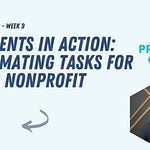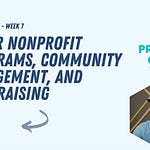Welcome to Week 3! In our first two weeks, we laid the groundwork, defining what AI is and getting comfortable with the basics of tools like ChatGPT and Gemini. You’ve seen how they can handle everyday tasks, from drafting emails to summarizing information. Now, it's time to go deeper.
This week, we're unlocking the more advanced features of these powerful AI tools. Our goal is to show you how to move beyond simple prompts and transform AI into a truly personalized assistant that can tackle complex challenges, streamline your workflows, and significantly boost your nonprofit’s impact. Get ready to discover new ways to save time and work smarter!
Going Deeper with ChatGPT: Advanced Features
ChatGPT isn't just for quick questions; it has powerful features that can turn it into an indispensable part of your workday.
A. Custom GPTs: Your Personalized AI Assistant
Imagine having an AI assistant that specializes in exactly what you need – whether it's grant writing, social media, or volunteer coordination. That’s what Custom GPTs are. Think of them as specialized versions of ChatGPT that you can tailor or even "teach" for a specific purpose. Instead of a general AI, you can configure a Custom GPT to be an expert in a particular area, making it incredibly focused and efficient for your nonprofit's unique needs.
How they help nonprofits:
Grant Writing Assistant: You could create a Custom GPT specifically for grant writing. You’d "train" it with your organization’s mission, past successful grant narratives, and common requirements from funders.
Volunteer Coordinator: Another Custom GPT could be set up to answer FAQs from volunteers, help draft recruitment messages, or assist in managing volunteer schedules.
B. Projects: Organize and Centralize Your Work
Projects in ChatGPT provide a powerful way to stay organized. You can store files, notes, and conversations all in one place, allowing you to build a centralized workspace for specific campaigns, programs, or ongoing tasks.
How it helps nonprofits:
Centralized Reference Hub: Keep your fundraising materials, grant narratives, donor lists, and brainstorming notes together.
Collaboration: Work on multiple files simultaneously and refer back to earlier versions or inputs without needing to re-upload or re-prompt.
C. Memory: AI That Remembers
Have you ever wished an AI could remember your preferences or the context of past conversations? With memory, ChatGPT can. This feature allows the AI to recall information from your previous interactions with it.
How it helps nonprofits:
Personalized Donor Communications: Tailor messages based on previous interactions or donor preferences.
Consistent Brand Voice: Maintain a steady tone and messaging across all communications.
D. Voice Input: Talk to Your AI
Sometimes typing can be slow or inconvenient. Voice input allows you to simply speak your prompts to ChatGPT instead of typing them out.
How it helps nonprofits: Capture ideas quickly, dictate meeting notes, or draft quick messages while multitasking.
E. Deep Research Capabilities: AI as Your Research Assistant
ChatGPT can access and synthesize vast amounts of information. Its deep research capabilities are ideal for exploring complex topics and providing detailed summaries.
How it helps nonprofits: Research new funders, understand community needs, and explore best practices for program delivery.
Leveraging Gemini for Visual & Document-Based Queries
While ChatGPT excels at text-based interactions, Gemini truly shines with its "multimodal" capabilities. It can process and understand text, images, and documents.
Relevant Nonprofit Use Cases:
Analyzing Infographics and Visual Data: Upload infographics and ask Gemini to summarize findings or extract data.
Creating Infographics: Use Gemini to generate visuals that communicate data or program impact in a compelling, easy-to-share format.
Summarizing Reports and PDFs: Ask Gemini to summarize annual reports, extract key metrics, or compare documents.
Extracting Info from Grant Guidelines: Quickly find critical requirements and deadlines within dense PDF files.
Analyzing Screenshots: Upload dashboard screenshots for insights and quick data summaries.
Comparing Responses Across Tools: Finding Your Best Fit
As you use both ChatGPT and Gemini, you’ll notice they approach tasks differently. This diversity is an asset. Comparing responses helps you determine which tool fits which task best.
Key Comparison Criteria:
Accuracy
Tone and Voice
Clarity
Relevance to Nonprofit Context
Creativity
Efficiency
Practical Exercise: Take a real task and run the same prompt through both tools. Analyze which tool delivers better results based on your needs.
Chaining Tasks & Building Mini Workflows
Nonprofit tasks often involve multiple steps. By chaining tasks, you can create mini workflows where AI supports each step in sequence.
Example Workflow: Crafting a Large Donor Email
Step 1: Brainstorm Messages (ChatGPT)
Step 2: Draft Subject Lines (ChatGPT)
Step 3: Write Email Draft (ChatGPT or Gemini)
Step 4: Refine & Personalize (Gemini or ChatGPT with memory)
This approach increases efficiency, reduces manual work, and maintains consistency.
TheGoodCollective.US is supported by my friends at Green Mellen.
Challenge for the Week:
Use both ChatGPT and Gemini to solve a real problem in your nonprofit work.
Document your process:
The problem you addressed
Which tool you used for each part
The prompts you used
The results you achieved
Your reflections on the process
This hands-on challenge will deepen your understanding and help you find the best fit for each tool in your workflow. Good luck!








